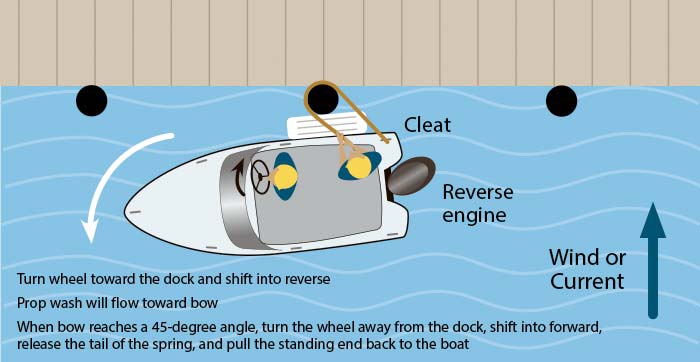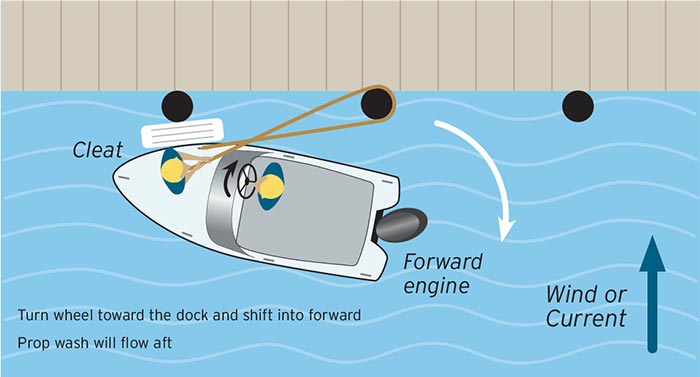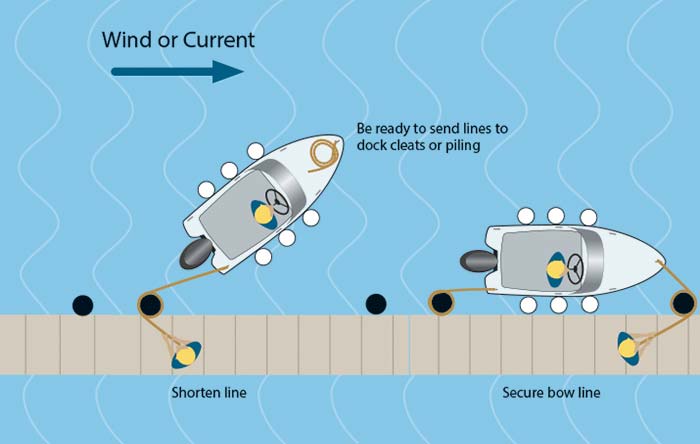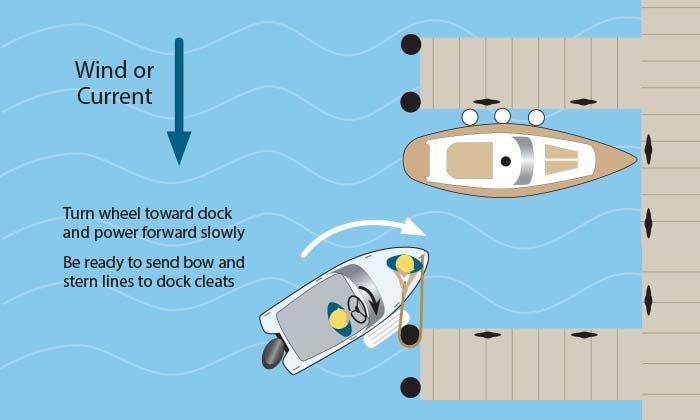Advertisement
Docklines are for more than just tying up your boat. Here's 5 techniques that can help you maneuver in tricky situations.

Springing off is a great technique if you need to get off the dock and have a boat in front of and behind you, such as at the fuel dock, or the wind/current is pushing you against the dock.
To those in the know, our docklines offer a bounty of potential beyond simply keeping our boats snugly tied at the dock. These include their use in maneuvering a vessel in tight quarters or under adverse circumstances, such as high winds, strong currents, no motor, or lack of crew. Here are a few basic techniques that allow your docklines to go above and beyond their normal duties.
Springing Off
When the wind is up and you're pinned against the dock, it's time to use probably the most well-known of the dockline-assist techniques — springing off. Use a spring line and sturdy dock cleat or piling to angle yourself off of a dock. Requirements are a couple of large fenders and a crew member, one that has been briefed on the procedure beforehand and knows what's expected. Steps will vary, depending on whether you want to leave the dock stern-first or bow-first, and other circumstances such as wind strength, current, and proximity of other boats. But basically, in each case, the spring line is looped around a dock cleat or piling located amidships, with both ends attached to the boat at the end opposite to the end that you want to move away from the dock. In both cases, the lines are attached to the vessel on the side that is against the dock.
Technique 1: Springing Off The Dock Bow-First
- Place fenders between the boat and the dock at the stern to prevent damage. Instruct the crew member to observe and adjust the position of the fenders as necessary throughout the maneuver to protect the boat.
- Rig a spring line from the aft cleat on the boat, loop it around a dock cleat or piling that is located roughly amidships of the boat, then run it back on board to the same aft cleat. Secure (cleat it off).
- Remove all other docklines.
- Station the crew member at the stern line, where they'll unwrap the top turn of the spring line, keeping a turn around the cleat and holding the bitter end of the line.
- Shift the engine into reverse, placing tension on the line.
- Turn the wheel (rudder) toward the dock, which will cause the bow to swing out.
- When the bow reaches a 45-degree angle away from the dock, shift the engine into forward while turning the wheel away from the dock.
- As tension is removed from the spring line, the crew member releases the tail of the line or bitter end, grabs the cleated end of the line, and quickly pulls the line free of the dock cleat or piling and onto the vessel.
- Once well clear of the dock, bring the fenders on board.
Technique 2: Springing Off The Dock Stern-First

- Place fenders between the boat and dock at the bow to prevent damage. Instruct the crew member to observe and adjust the position of the fenders as necessary throughout the maneuver to protect the boat.
- Rig a spring line from the bow cleat of the boat, loop it around a dock cleat or piling that is located roughly amidships of the boat, then run it back on board to the same bow cleat and secure.
- Remove all other docklines.
- Station the crew member at the bow line, where they'll unwrap the top turn of the spring line, keeping a turn around the cleat and holding the bitter end of the line.
- Shift the engine into forward, placing tension on the spring line.
- Turn the wheel (rudder) toward the dock, which will cause the stern to swing out.
- When the stern reaches a 45-degree angle away from the dock, shift the engine into reverse while turning the wheel away from the dock.
- As the tension is removed from the spring line, the crew member releases the tail of the line or bitter end, grabs the cleated end of the line, and quickly pulls the line free of the dock cleat or piling and onto the vessel.
- Once well clear of the dock, bring the fenders onboard.
Technique 3: Checking A Line
This technique allows you to use a cleat or piling to adjust a vessel's position, or move it along a dock in the direction of the prevailing wind or current. Checking a line allows you to adjust or feed line out while using the strength of a cleat or piling to maintain control.
Let's say you're moored port side to a dock and need to shift your vessel forward a few feet to free up space for another boat to dock at your stern. The wind is howling, but luckily blowing from your stern and along the dock in the direction you need to move. Use the wind to move your boat along the dock while keeping it under control with your port stern line.

A half turn on the piling or cleat should be plenty, but add more wraps if you need greater leverage for a larger boat or stronger current.
- Untie all docklines except the stern line. If it looks like the wind might blow the bow away from the dock, have someone hold the bowline while walking along the dock.
- If the stern line is tied directly to the dock, loosen the line at the port stern cleat, but keep a half turn (or more, if needed) on the cleat while holding the bitter end of the line, applying tension to prevent it from paying out.
- When ready to shift the boat, reduce pressure on the line slightly, allow the line to pay out in a controlled manner.
- Once the boat has shifted to the desired position, check the stern line by wrapping it around the cleat and securing it as normal.
- If the stern line is looped around the dock cleat and attached back at the stern cleat, the process would be very similar. In this situation, one end of the stern line would remain attached to the cleat. When ready to shift the vessel, feed out more line from the bitter end while checking it as described above.
Advertisement
A couple of notes: The above scenario assumes the stern line is strong enough and of sufficient length to reposition the boat to the new location. If not, replace it with a longer line prior to shifting. Once secured, you may need to shift the stern line to another dock cleat or piling, if there is another one that is better positioned.
If there is concern about keeping the vessel under control (due to stronger winds or current) you can have a crew member check the bow line as well during the maneuver. Finally, you can also use checking to control a vessel in other situations. When docking during high wind or current situations, a dockline with one or two wraps around a piling can be used to control movement into a slip or berth by simply adjusting pressure on the line.
Technique 4: Flipping A Boat
Flipping a boat is a technique that allows you to change the bow/stern orientation of your vessel without starting the engine. It's used when a vessel is tied alongside a dock with a strong current or wind running parallel to the dock.
Let's say you used the current as a brake when docking and are now oriented bow into the current, port side to the dock. The problem, however, is the current will shift and be running in the opposite direction by the time you are ready to leave. You want to take off with the bow into the current because of lack of space between you and the other boats around you. Use lines to reverse the boat's orientation while maintaining control and not becoming unattached to the dock.


Flipping a boat allows you to change its orientation along the dock without having to use the engine.
- Attach a line of sufficient length to the opposite stern cleat — in this case, the starboard stern cleat. Route this line aft of the transom and attach to a cleat or dock piling down current from the cleat the port stern line is attached to, placing the port line on top so you can release it first.
- Place fenders along the starboard side of the vessel. Position them as you normally would when docking. Have someone aboard to offer the bowline to someone on the dock.
- Free all lines from the dock and leave them on board, with the exception of the starboard stern line.
- Push the bow away from the dock. The current will catch the bow and swing it away from the dock, while the starboard stern line will act as a pivot point. Prepare to shorten the line.
- Once the boat is laying starboard side to the dock, secure it as normal. It may be necessary to shorten this line as the maneuver progresses to avoid having your boat move too far back, fouling another boat.
Note: As a precaution, the captain (or someone who can operate the vessel) should stay onboard while flipping the vessel or performing most of these operations. Often having the engine running in neutral, ready to be shifted into the gear appropriate for the circumstances, can add an extra measure of safety should things go awry.
While you can do this maneuver singlehandedly in a pinch, having an extra set of hands on the dock to cast off the bow line and keep the transom from bumping the dock as the vessel pivots is highly recommended.
Technique 5: Entering A Slip With A Strong Parallel Current Or Crosswind
Coming into a slip with strong parallel current or wind can be tricky, but the use of docklines can once again help keep things safe and under control.
In the scenario below, let's assume you're approaching a slip on your starboard side.

Tight slip and working against the wind/current? This technique will help you get into the slip safely and in a controlled manner.
- Have a crew member attach a dockline to the starboard bow cleat and stand at the ready.
- Approach the slip while heading into the wind or current. Your speed should be just enough to maintain steerage (vessel control).
- Angle into the slip and lay the starboard side of the boat (just aft of the bow) alongside the end piling of the slip which is downstream from the direction of the wind or current flow. The goal is to use the wind or current to intentionally pin the vessel onto the piling.
- Have the crew member attach the bow line to the piling with a few wraps and hold the bitter end.
- As you motor around the piling and into the slip, the crew member will use the line as a brake, letting it play out under control by checking the line as needed to warp the boat around the piling and into the slip.
And Keep These Points In Mind
- During the learning process, go slowly. Think out every step. Avoid undue risks; keep hands and other body parts out of danger. Always weigh which is the safest tactic to use.
- Practice breeds familiarity. Once you have the basics down for a particular technique or maneuver, practice as often as needed to execute it properly and maintain proficiency.
- Revisit a technique when training new crew members or if there are fewer crew members on board than usual. No maneuver should be attempted if undercrewed or the crew is too inexperienced.
- Length and strength of line needed must be assessed in all situations.
